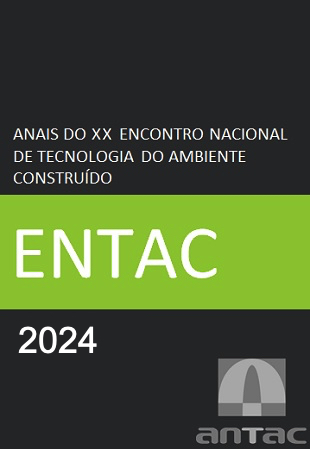Simulation of urban shading to mitigate heat islands in irregularly dense areas
DOI:
https://doi.org/10.46421/entac.v20i1.6275Keywords:
Microclimate simulation, Human thermal comfort, Heatwaves, Urban Shading, Recycled materialAbstract
Heat islands are intensified by climate change, leading to episodes of heatwaves in cities. Faced with this issue, within the context of the city of Belo Horizonte, this study aimed to improve thermal comfort conditions on a narrow street with irregular density by designing urban shading structures with different inclinations, made from PET (Polyethylene Terephthalate) plastic bottles, a recycling material from local residents. The shading structures were studied based on local ventilation conditions and solar incidence. Simulations were conducted using Rhinoceros 6 and Rayman PRO software to assess the potential for heat reduction. The results revealed a significant decrease in solar radiation at the study site, leading to a reduction in the thermal index PET ranging from 5.4°C to 11.3°C, highlighting the potential for improving human thermal comfort and reducing physiological stress. Therefore, it is concluded that the use of urban shading structures can be a sustainable, technically and economically viable solution, proving to be efficient in mitigating heat islands in densely populated urban areas.
References
OSMOND, P.; SHARIFI, E. Guide to Urban Cooling Strategies. 2017. Disponível em: http://www.lowcarbonlivingcrc.com.au/sites/all/files/event_file_attachments/crc_lcl_urban_cooling_guide_2017_web.pdf. Acesso em: 20 agosto 2020.
FOROUDI, L. The architecture of heat: how we built before air-con. Financial Times, Architecture, August 28, 2020. Disponível em: https://www.ft.com/content/839d4ccf-269f-44fe-914b-544644a4c819. Acesso em 18 dezembro 2021.
GARCIA-NEVADO, E.; BECKERS, B.; COCH, H. Assessing the cooling effect of urban textile shading devices through time-lapse thermography. Sustainable Cities and Society, v. 63, 2020, 102458.
BANDE, L.; GUERRA CABRERA, A.; MARPU, P.; AFSHARI, A. Urban smart shading devices based on traditional Gulf design. Case study located in a district of a hot-arid climate city (Abu Dhabi). In: IEEE INTERNATIONAL SMART CITIES CONFERENCE, 1., 2015, Guadalajara. Proceedings [...] Guadalajara: IEEE, 2015. p. 1-6. Disponível em https://hdl.handle.net/11311/983727. Acesso em 18 dezembro 2021.
LAM, C. K. C.; WENG, J.; LIU, K.; HANG, J. The effects of shading devices on outdoor thermal and visual comfort in Southern China during summer. Building and Environment, v. 228, 2023. DOI: https://doi.org/10.1016/j.buildenv.2022.109743
MATA, D. D.; LALL, S. V.; WANG, H.G. Favelas e dinâmica das cidades brasileiras. In: CARVALHO, A.X.Y. et al, (Eds.) Ensaios de Economia Regional e Urbana. Brasília: IPEA, 2007. p. 47-64.
MORAIS, J.A.M. Análise exploratória de diferenças de conforto térmico entre dois padrões de ocupação urbana representados por ocupação espontânea e por ocupação planejada. 2011. 180 f. Dissertação (Mestrado em Engenharia Ambiental Urbana) - Universidade Federal da Bahia, Salvador, 2011.
GUSSON, C.D.S. Efeito da densidade construída sobre o microclima urbano: construção de diferentes cenários possíveis e seus efeitos no microclima para a cidade de São Paulo, SP. 2014. 152 f. Dissertação (Mestrado em Tecnologia da Arquitetura) - Universidade de São Paulo, São Paulo, 2014.
HIRASHIMA, S. Q. S. Calibração do índice de conforto térmico Temperatura Fisiológica Equivalente (PET) para o município de Belo Horizonte. 2010. 225 f. Dissertação (Mestrado em Ambiente Construído e Patrimônio Sustentável) - Universidade Federal de Minas Gerais, Belo Horizonte, 2010.
REBOITA, M. S.; RODRIGUES, M.; SILVA, L. F.; ALVES, M. A. Aspectos climáticos do estado de Minas Gerais. Revista Brasileira de Climatologia, v. 17, 2015, p. 206-226.
GROAT, L.; WANG, D. Architectural Research Methods. 2nd ed., New Jersey: Wiley, 2013.
WOODBURY, R. Elements of Parametric Design. New York: Routledge, 2010
HERNANDEZ, C. Thinking parametric design - introducing parametric Gaudi. Design Studies, v. 27, n. 3, 2006, p. 309-324.
OXMAN, R. Digital architecture as a challenge for design pedagogy: theory, knowledge, models and medium. Design Studies, v. 29, n.2, 2008, p. 99-120.
INMET – Instituto Nacional de Meteorologia. Dados Históricos Anuais. Brasília, 2023. Disponível em: https://portal.inmet.gov.br/dadoshistoricos. Acesso em: 30 outubro 2023.
LAMBERTS, R.; DUTRA, L.; PEREIRA, F. O. R. Eficiência energética na arquitetura. 3 ed. Rio de Janeiro: ELETROBRÁS/PROCEL, 2012.
FROTA, A. B.; SCHIFFER, S. R. Manual de Conforto Térmico. 2. ed. São Paulo: Nobel, 1995.
TEJEDA-MARTINEZ, A.; JAUREGUI-OSTOS, E. Surface energy balance measurements in the Mexico City region: a review. Atmósfera, v. 18, n. 1, 2005, p. 1-23.
STEWART, I. D. Local Climate Zone for Urban Temperature Studies. Bull. Am. Meteorol. Soc., v. 93, n. 12, 2012, p. 1879-1900.
RODRIGUES, B. B.; COSTA, E. D. F.; ASSIS, E. S.; SILVA, F. J. In: ZERO ENERGY MASS CUSTOM HOME INTERNATIONAL CONFERENCE (ZEMCH), 10., 2023. Arequipa. Proceedings [...] Arequipa: ZEMCH Network/Universidad Catolica de San Pablo, 2023. 6p.
PEREZ, R.; SEALS, R.; INEICHEN, P.; STEWART, R.; MENUCCUCCI, D. New simplified version of the Perez Diffuse Irradiance Model for tilted surfaces. Solar Energy, v.39, n.3, 1987, p. 221-231.
ASSIS, E. S.; FIGUEIREDO, A. M.; MASCARELLO, A. V. S. Análise da percepção de variáveis climáticas urbanas por residentes da cidade de Belo Horizonte, Brasil. In: CONGRESSO LUSO-BRASILEIRO PARA O PLANEJAMENTO URBANO, REGIONAL, INTEGRADO E SUSTENTÁVEL, 7º, 2016, Maceió. Anais [...] Maceió: Universidade Federal de Alagoas, 2016, 12 p.

